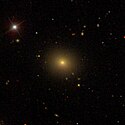IC 670
| Galaxie IC 670 | |
|---|---|
 | |
| SDSS-Aufnahme | |
| AladinLite | |
| Sternbild | Löwe |
| Position Äquinoktium: J2000.0, Epoche: J2000.0 | |
| Rektaszension | 11h 07m 28,8s[1] |
| Deklination | +06° 42′ 51″[1] |
| Erscheinungsbild | |
| Morphologischer Typ | E+[1] |
| Helligkeit (visuell) | 13,5 mag[2] |
| Helligkeit (B-Band) | 14,5 mag[2] |
| Winkelausdehnung | 1′ × 0,8′[2] |
| Positionswinkel | 51°[2] |
| Flächenhelligkeit | 13,3 mag/arcmin²[2] |
| Physikalische Daten | |
| Rotverschiebung | 0.029095 ± 0.000010[1] |
| Radialgeschwindigkeit | (8722 ± 3) km/s[1] |
| Hubbledistanz H0 = 73 km/(s • Mpc) | (385 ± 27) 𐄁 106 Lj (118,0 ± 8,3) Mpc [1] |
| Durchmesser | 110.000 Lj[3] |
| Geschichte | |
| Entdeckung | Rudolf Spitaler |
| Entdeckungsdatum | 7. März 1891 |
| Katalogbezeichnungen | |
| IC 670 • UGC 6178 • PGC 33680 • CGCG 038-134 • MCG +01-28-041 • 2MASX J11072877+0642515 • | |
IC 670 ist eine elliptische Galaxie vom Hubble-Typ E im Sternbild Löwe auf der Ekliptik. Sie ist schätzungsweise 385 Millionen Lichtjahre von der Milchstraße entfernt.
Das Objekt wurde am 7. März 1891 von dem österreichischen Astronomen Rudolf Spitaler entdeckt.[4]
Weblinks
Einzelnachweise
Auf dieser Seite verwendete Medien
Autor/Urheber: Sloan Digital Sky Survey, Lizenz: CC BY 4.0

Angle of view: 4' × 4' (0.3" per pixel), north is up.
Details on the image processing pipeline: https://www.sdss.org/dr14/imaging/jpg-images-on-skyserver/